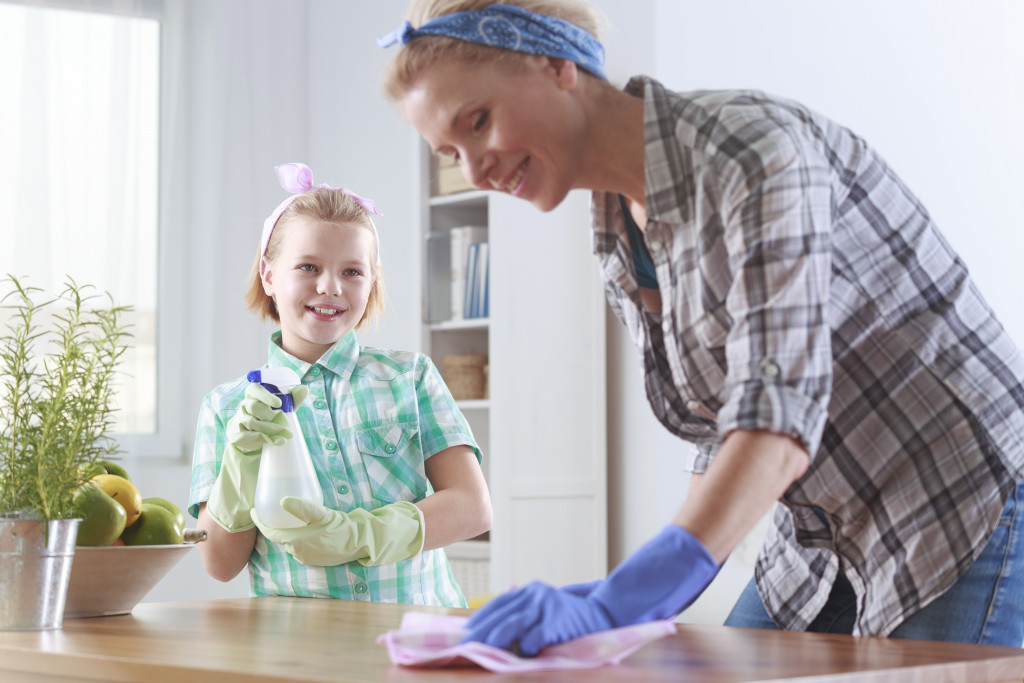- Regular dusting and vacuuming are essential cleaning tasks to help reduce allergens and irritants in the home.
- Ensure proper food preparation techniques like washing hands before cooking or eating and wiping surfaces clean during meal preparation.
- To avoid cross-contamination, practice effective separation methods when storing and preparing food items.
- Store perishable foods in the fridge at specific temperatures to prevent bacterial growth and spoilage.
- Seek professional help if you suspect a pest infestation, as they can spread diseases and bacteria around the home.
Living in a clean and healthy home is essential for your overall well-being. It not only helps in reducing allergens and infections but also promotes mental and emotional peace. A healthy home is vital for everyone, especially young children, pregnant women, and older adults.
A clean and healthy home environment has numerous benefits for the entire family. It helps to reduce the chances of infections, allergies, and respiratory problems. A clean home also promotes mental and emotional well-being.
When your home is clean, you feel more relaxed and less stressed. Additionally, research shows that a clean home can help you sleep better and improve your overall quality of life. This blog will provide some essential tips to help you create and maintain a healthy home environment.
Cleaning and Sanitizing Practices
One of the most important aspects of maintaining a healthy home is cleaning and sanitizing. Cleaning involves the removal of dirt and grime, while sanitizing consists of the killing of germs and bacteria. Following proper cleaning and sanitizing practices is essential to keep your home safe and clean.
Cleanliness is one of the cornerstones of a healthy home. Regular cleaning practices such as dusting, vacuuming, and wiping down surfaces can help reduce the number of allergens and irritants in your home.
It’s essential to clean and organize your home to reduce the risk of infections and diseases and promote mental and emotional well-being.
Essential Cleaning Routines
To create a healthy home environment, it’s essential to have a regular cleaning routine. This will help you stay on top of the cleaning tasks and keep your home clean and organized.
Regular Dusting and Vacuuming
Dusting and vacuuming are some of the most essential cleaning tasks that must be done regularly. Dust can accumulate on surfaces and corners, leading to allergies and respiratory problems. Vacuuming regularly, especially if you have pets, can help reduce the amount of dust and allergens in your home.
Proper Disposal of Waste and Garbage
Proper waste management is essential for a healthy home environment. It’s important to have appropriate waste disposal methods and to dispose of trash regularly to reduce the chances of disease and infection. You should also separate recyclable and non-recyclable waste and use eco-friendly products when possible.
Cleaning Kitchen and Food Preparation Areas
The kitchen is one of the most critical areas in your home that needs to be kept clean and organized. Food preparation areas should be cleaned and sanitized regularly to reduce the risk of foodborne illnesses and contamination. You should also clean the fridge and other appliances regularly to prevent the growth of bacteria.
Bathroom and Toilet Hygiene
The bathroom and toilet are some of a home’s most commonly used areas. Keeping these areas clean and hygienic is essential to reduce the risk of infections and illnesses.
It would be best to regularly clean the bathroom and toilet, including the sink, shower, and bathtub. Moreover, using a disinfectant to kill germs and bacteria would be best.
Floor and Surface Cleaning
Cleaning floors and surfaces is essential for a healthy home environment. You should sweep and mop floors regularly, especially in high-traffic areas such as the hallway and kitchen. You should also wipe down surfaces, including countertops and tables, to prevent the growth of bacteria and germs.

Home Food and Beverage Safety
The food you consume is correlated to your physical well-being. Following best food and beverage safety practices is vital to ensure healthy sustenance. Here are some best practices to keep in mind.
Proper Storage of Perishable Foods
Refrigeration prevents bacterial growth and spoilage of food. Proper storage of perishable foods helps to maintain their taste and quality.
Always store perishable foods such as eggs, dairy, and meat in the refrigerator. Keep them at specific temperatures and avoid storing them for too long.
When storing food in the freezer, ensure it is in airtight containers or freezer bags to prevent freezer burn.
Hygienic Food Preparation Techniques
Cleanliness and hygiene extend to food preparation practices. Ensure that you wash fruits and vegetables thoroughly before cooking or consumption. Use clean cooking utensils, cutting boards, and dishes for food preparation. When making eggs, use clean hands and utensils and cook them to the appropriate temperature.
Avoiding Cross-Contamination
Cross-contamination is a significant contributor to foodborne illnesses. To avoid cross-contamination:
- Practice effective separation techniques when storing and preparing meals.
- Keep food items that may cause contamination separate from others.
- Use specific utensils and cutting boards for different food items. This may seem tedious, but it’s necessary for good hygiene practices in the kitchen.
Foodborne Illness Prevention
Foodborne illnesses can be devastating to your overall health. Common causes of foodborne diseases include improper storage, poor hygiene, and cross-contamination. Cook food to the recommended temperature and store perishable foods at the correct temperature to avoid bacterial growth and spoilage.
Proper food handling techniques such as washing hands before cooking or eating and wiping surfaces clean during meal preparation will help you stay healthy and prevent illnesses.
Pest Infestation
Pests are a serious health hazard in homes. Apart from the discomfort they cause, pests like rodents and roaches can harbor diseases and bacteria. To prevent pest infestation, keep your home tidy, store food in airtight containers, and place trash in sealed garbage cans.
However, despite best efforts, pest infestations can still occur. It’s crucial to identify the signs of an infestation. If you notice any signs or suspect a pest problem, it’s advisable to seek professional help from a reputable food and beverage pest control service.
F&B pest control services are specialists trained in identifying and treating pest infestations in commercial and residential settings. They have the expertise and knowledge to effectively eradicate pests, implement preventive measures, and ensure compliance with health and safety regulations.

A healthy home environment is essential for everyone. Following these tips can create a clean and safe living environment for you and your family.
Regular cleaning and sanitizing practices, proper waste disposal, and maintaining kitchen and bathroom hygiene are essential elements of a healthy home.
Remember, a clean and healthy home promotes physical but also mental and emotional well-being.


















